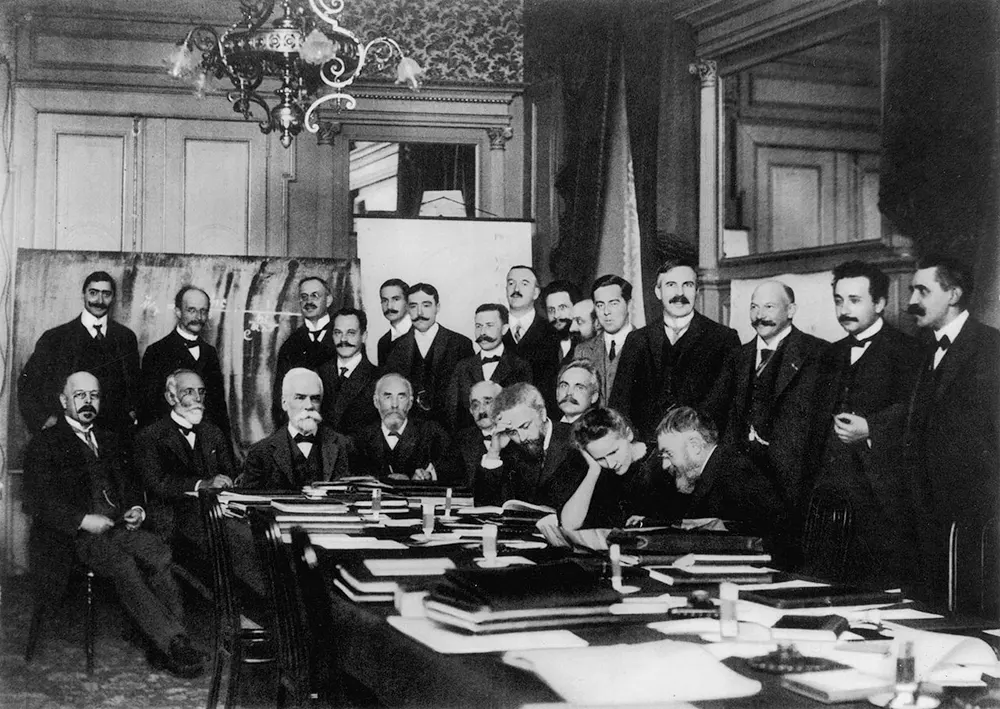When Genius Gathered in Brussels
Picture this: It's October 1927 in Brussels, Belgium. The world's most brilliant physicists have gathered for what would become the most famous scientific conference in history. Of the 29 attendees, 17 were or became Nobel Prize winners. This wasn't just a meeting, it was the moment when our modern understanding of the universe was born.
The photograph we see captures more than just people in suits. We're looking at the architects of modern physics, the minds that unlocked the secrets of atoms, energy, and the very fabric of reality.
The Revolutionary Context
The fifth (1927) physics conference was particularly influential in the development of quantum mechanics, coming at a critical moment when classical physics was crumbling and quantum mechanics was emerging. The leading figures were Albert Einstein and Niels Bohr, and their famous debates about the nature of reality would echo through decades of scientific thought.
Einstein, disenchanted with Heisenberg's uncertainty principle, remarked "God does not play dice". Bohr replied: "Einstein, stop telling God what to do". This exchange perfectly captures the revolutionary tension of the moment.
The Brilliant Minds: Front Row (Seated)
Albert Einstein

Revolutionary Contributions: Theory of Special and General Relativity, E=mc²
Einstein's theory of relativity transformed theoretical physics and astronomy during the 20th century, superseding a 200-year-old theory of mechanics created primarily by Isaac Newton. His famous equation E=mc² revealed that mass and energy are different forms of the same thing—a secret that had eluded scientists for centuries. His work fundamentally changed our understanding of space, time, and gravity.
Marie Curie

Revolutionary Contributions: Discovery of Radioactivity, Polonium, and Radium
She shared the 1903 Nobel Prize in Physics with her husband Pierre and Henri Becquerel for their pioneering work developing the theory of "radioactivity"—a term she coined. She won the 1911 Nobel Prize in Chemistry for her discovery of the elements polonium and radium. Marie Curie remains the only person to win Nobel Prizes in two different scientific fields, and her work laid the foundation for nuclear physics and cancer treatment.
Max Planck

Revolutionary Contributions: Quantum Theory and Planck's Constant
Planck introduced the revolutionary concept that energy comes in discrete packets called "quanta," launching the quantum revolution. His work on blackbody radiation solved a major problem in classical physics and earned him the 1918 Nobel Prize in Physics.
Hendrik Lorentz

Revolutionary Contributions: Lorentz Transformations and Electromagnetic Theory
Lorentz developed the mathematical transformations that became crucial to Einstein's special relativity. His work on electromagnetic theory and electron dynamics was fundamental to modern physics.
Charles Thomson Rees Wilson
Revolutionary Contributions: Cloud Chamber for Detecting Particles
Wilson invented the cloud chamber, which made it possible to see the tracks of subatomic particles for the first time. This breakthrough tool earned him the 1927 Nobel Prize and revolutionized particle physics.
The Brilliant Minds: Middle Row
Niels Bohr
Revolutionary Contributions: Atomic Model and Copenhagen Interpretation
Bohr developed the Bohr model of the atom, in which he proposed that energy levels of electrons are discrete and that electrons revolve in stable orbits around the atomic nucleus but can jump from one energy level to another. He was the founding father of the Copenhagen interpretation of quantum mechanics, along with Werner Heisenberg and Max Born. His work earned him the 1922 Nobel Prize and established the foundation for quantum mechanics.
Werner Heisenberg
Revolutionary Contributions: Quantum Mechanics and Uncertainty Principle
Heisenberg formulated the fundamental uncertainty principle, which states that you cannot precisely know both the position and momentum of a particle simultaneously. He developed matrix mechanics, one of the first formulations of quantum theory, earning the 1932 Nobel Prize.
Paul Dirac
Revolutionary Contributions: Quantum Field Theory and Antimatter
Dirac merged quantum mechanics with special relativity and predicted the existence of antimatter. His equation describing electron behavior led to the discovery of positrons and earned him the 1933 Nobel Prize.
Erwin Schrödinger
Revolutionary Contributions: Wave Equation and Wave Mechanics
Schrödinger matched observed quantum behavior with the properties of a continuous nonrelativistic wave obeying the Schrödinger Equation. His wave mechanics provided an alternative formulation to Heisenberg's matrix mechanics and became fundamental to quantum theory.
Louis de Broglie
Revolutionary Contributions: Wave-Particle Duality
De Broglie proposed that all matter has wave properties, not just light. This revolutionary idea helped bridge the gap between particle and wave descriptions of matter, earning him the 1929 Nobel Prize.
Max Born
Revolutionary Contributions: Statistical Interpretation of Quantum Mechanics
Born provided the statistical interpretation of the wave function, showing that it represents probability rather than physical reality. His work on quantum scattering theory earned him the 1954 Nobel Prize.
The Historic Debates
Einstein vs. Bohr: The Battle for Reality
The debates between Niels Bohr and Albert Einstein at the Solvay Conferences in 1927 and 1930 include some of the most intense and deep exchanges of views on physics and its philosophy in the twentieth century.
Einstein never accepted the Copenhagen interpretation, famously declaring against its probabilistic implications that "God does not play dice". He believed quantum mechanics was incomplete and spent the rest of his life searching for a more complete theory.
Again and again Einstein presented thought experiments that disproved the Copenhagen Interpretation. Each time Niels Bohr slept on the problem and by the following day he could ingeniously contradict Einstein's objections.
The Revolutionary Ideas Discussed
Quantum Mechanics Revolution
The conference focused on the newly formulated quantum theory, where at the 1927 Solvay Conference, a dual talk by Max Born and Heisenberg declared "we consider quantum mechanics to be a closed theory, whose fundamental physical and mathematical assumptions are no longer susceptible of any modification".
Wave-Particle Duality
According to Bohr's complementarity principle, light is neither a wave nor a stream of particles. A particular experiment can demonstrate particle behavior or wave behavior, but not both at the same time.
The Uncertainty Principle
Heisenberg's uncertainty principle challenged the classical notion that we could know everything about a particle's state with perfect precision.
Why This Picture Matters Today
Modern Technology Foundations
The ideas discussed at this conference led directly to:
- Computers and smartphones (quantum mechanics enabled the transistor)
- Medical imaging (MRI, CT scans based on quantum principles)
- GPS systems (requires Einstein's relativity for accuracy)
- Nuclear energy (E=mc² made nuclear power possible)
- Lasers and LED lights (quantum mechanics principles)
Current Scientific Frontiers
We're still building on their work:
- Quantum computing promises to revolutionize technology
- Particle accelerators continue to probe the fundamental nature of matter
- Space exploration relies on Einstein's theories
- Medical treatments use radioactivity discovered by the Curies
The Human Story Behind the Science
Breaking Barriers
Marie Curie faced enormous discrimination as a woman in science but persevered to become the first woman to win a Nobel Prize. She is still the only individual to receive the prize in two different science categories.
Collaboration Across Borders
Despite political tensions in Europe, these scientists collaborated across national boundaries, showing how science transcends politics and brings humanity together.
The Cost of Discovery
Both Curies were constantly ill from radiation sickness, and Marie Curie's death from aplastic anemia in 1934, at age 66, was likely caused by radiation exposure. Many of these pioneers sacrificed their health and sometimes their lives for scientific knowledge.
The Legacy Lives On
Educational Impact
The ideas from this conference became the foundation of modern physics education. Every science student today learns about Einstein's relativity, Bohr's atomic model, and Heisenberg's uncertainty principle.
Philosophical Implications
These discoveries changed not just science, but philosophy. They challenged our basic understanding of reality, causality, and what we can truly know about the universe.
Future Generations
Marie Curie's contributions to physics were immense, not only in her own work, as indicated by her two Nobel Prizes, but also through her influence on subsequent generations of nuclear physicists and chemists. Many of their students and intellectual descendants continued their work, creating scientific dynasties that persist today.
What We Can Learn
The Power of Questioning
These scientists weren't afraid to challenge established ideas. They questioned fundamental assumptions about reality and weren't satisfied with "that's just how things are."
Collaboration and Debate
The conference showed how scientific progress happens through collaboration, even when scientists disagree. The Einstein-Bohr debates, while they never reached complete resolution, pushed both scientists to refine their ideas.
Persistence in the Face of Mystery
Many of the quantum mechanical ideas seemed bizarre and counterintuitive, but these scientists persisted in trying to understand them rather than dismissing them.
The Continuing Revolution
The 1927 Solvay Conference wasn't the end of the physics revolution—it was the beginning. Today, we're still grappling with the implications of quantum mechanics:
- Quantum entanglement challenges our understanding of space and time
- The measurement problem in quantum mechanics remains unsolved
- Unifying quantum mechanics with general relativity remains one of physics' greatest challenges
Conclusion: A Moment That Changed Everything
When we look at this remarkable photograph, we're seeing more than just 29 people in formal attire. We're looking at the moment when humanity took a giant leap forward in understanding the universe.
These brilliant minds gathered in Brussels didn't just discuss abstract theories—they laid the groundwork for the modern world. Every smartphone, computer, MRI machine, and nuclear power plant exists because of the ideas discussed in that room.
The fifth Solvay Conference on Physics, which was held from 24 to 29 October 1927, was attended by some 30 of the world's leading physicists, and their discussions continue to shape science and technology today.
The most intelligent picture ever taken captures not just a moment in time, but the birth of our modern understanding of reality itself. These scientists showed us that the universe is far stranger and more wonderful than we ever imagined—and they gave us the tools to explore it.
The legacy of the 1927 Solvay Conference reminds us that the greatest breakthroughs often come from questioning what we think we know and being willing to embrace ideas that seem impossible. In a world facing complex challenges, we need that same spirit of curiosity, collaboration, and fearless inquiry that these remarkable minds brought to Brussels nearly a century ago.





